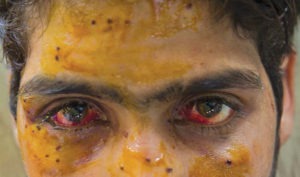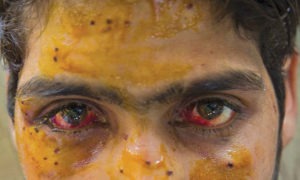‘Stem cell treatment is beneficial for people who suffer from macular degeneration (An eye disease that causes vision loss). But researchers think it could work for other kinds of vision loss as well’
Srinagar: Being blind partially or completely is not easy. Anyone can understand this much, especially people who know what ‘disability’ feels like. Probably, that’s why a space in Kashmir packed with ‘specially-abled’ people cheered up extraordinarily when the positive role of stem cell technology in treating the pellet victims from Kashmir-especially those hit by pellets in the eyes-was explained to them by Vice Chancellor of Islamic University of Science and Technology (VC IUST) Prof Mushtaq A Siddique.
“There is something good for the pellet victims who have been hit in the eyes during the recent uprising in 2016. The stem cell technology is going to give us the solution to many disabilities. In one or two years, we will have a real-time gene therapy technology. From the laboratory site, the retina has been well recovered using this technology. The pellet injuries in retinas will be recovered in a year or two,” he said recently at an event about how science and technology can help change the fate of ‘specially-abled’ Kashmiris, on May 13.
The audience couldn’t understand what all he said about the technology but the fact that it was going to change the fate of the pellet victims (people who have seen the world and are now deprived of it), made them cheer in joy.
“Khuda Bozin (May God grant this prayer),” said a specially-abled person sitting among the audience, in his wheelchair.
After the killing of Hizb ul Mujahideen Commander Burhan Muzaffar Wani on 8 July 2016, the valley witnessed a huge uprising with demands of ‘freedom’ from ‘Indian occupation’. Internet ban, protests, restrictions, curfews, strikes, firing, tear/ pepper gas shelling casualties and more than a hundred civilian killings have taken place since then. As per the reports, more than 25,000 civilians were injured. About 20,000 civilians suffered pellet injuries (16 locals died because they could not sustain the pellet injuries). 16 Kashmiris lost their eye sight completely while 243 lost partial eyesight.
So what is a Stem Cell?
The concept was explained to this reporter by Dr Arshad A Pandith, a Senior Scientist at Advanced Centre for Human Genetics, Sher-i-Kashmir Institute of Medical Sciences, Srinagar.
Dr Pandith said that the stem cells have a remarkable potential to develop into many different cell types in the body during early life and growth. In addition, in many tissues they serve as a sort of internal repair system, dividing essentially without limit to replenish other cells as long as the person or animal is still alive.
When a stem cell divides, each new cell has the potential of either to remain a stem cell or become another type of cell with a more specialized function, such as a muscle cell, a red blood cell, or a brain cell.
As per a document shared by Dr Pandith via email, the stem cell treatment is beneficial for people who suffer from macular degeneration (An eye disease that causes vision loss). But researchers think it could work for other kinds of vision loss as well.
How the Stem Cell Treatment works
To perform the stem cell transplant, researchers initially tested things out on blind mice. They injected stem cells into the rear of the eye. The stem cells were able to replace the damaged photo-receptors, which are small, important cells found in the retina. These photo-receptors are vital to your ability to see things and they are very sensitive to light.
Interestingly enough, previous studies using stem cells had failed to restore sight. One reason for the problem relates to the choice of stem cells.
In the most recent study, researchers used stem cells that were more mature than the ones previous researchers had used. The choice proved successful as the stem cells developed into photo-receptors and were able to join with the nerves that lead to the brain.
Researchers hope to see these kinds of transplants happening on a greater scale in approximately ten years, as per the document. With many patients suffering from diseases in the eye that cause photo-receptors to die, this research offers a way to provide photo-receptor transplantation, helping to restore eyesight for many people around the world.
The use of a patient’s own cells also avoids the potential for immunological rejection, a threat that comes with other types of treatment.
As far as the Kashmiri pellet victims are concerned, VC IUST Prof Siddique said, “Clinical trials (regarding the stem cell treatment) are going on, even in Delhi. It’s not only happening in America. The trials have three phases: Phase I, Phase II and Phase III. Once, Phase III is attained, the treatment is made available,” Siddique said.

Photo Credits: Baba Tamim.
He added, “During these trials, one or two patients are picked up to see what would happen. No such patient has been picked up from among the pellet victims here. However, AIIMS – All India Institute Of Medical Science’s Neurology Department is holding the trials at present. I don’t know which phase is it in now.”
He also said that the technology has shown positive results when it comes to other diseases of extremely dangerous injuries like the spinal cord injury.
“Spinal cord injury is the result of the loss of nervous tissue which further affects the motor and sensory functions. Such injuries are either affected by trauma or degenerative process of diseases. Stem cells which have a property of proliferation, migration and differentiation have been tried in regenerating the nerve cells in spinal cord injury so as to render affected experimental animals as normal. It has worked wonders and experimental trials have proved beyond doubt that paraplegia is treatable through such an intervention which otherwise was not treatable,” Prof Siddique shared via email.
“Clinical trials using embryonic stem cells met with resistance due to ethical and moral issues. However, Indian scientists from Lifeline Institute of Stem Cell Therapy and Research, Surat claimed to have used self-generated Stem cells in order to overcome controversial embryonic stem cell use. They claim that “25-year-old Akbar who had come on a stretcher is normally walking looking for a bride” with an overall success of 34%,” he further mentioned.
“Similarly, in experimental animals retinal cell degenerative disorders have been tried with stem cells using embryonic or induced pluripotent stem cells with a large success. Such a treatment by stem cells have been able to generate Retinal Ganglion Cells, Retinal photo-receptors and Retinal pigment epithelium which are usually destroyed in a variety of visual disorders,” he had written while he told this reporter over the phone that stem cell technology can actually benefit the pellet victims in Kashmir.
However, he said that the cost of such treatments has not been estimated as of now.
The experts do still tend to warn that we should not assume this study means we automatically have a cure for blindness. But it does offer hope for people who are blind from macular degeneration that they may one day regain eyesight.
Although there have been many breakthrough studies into stem cell therapies, there have also unfortunately been some disappointments as well.








